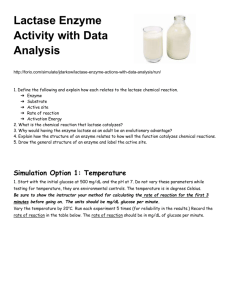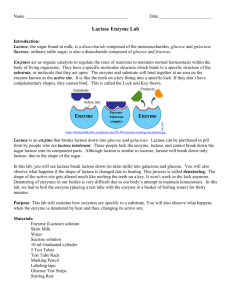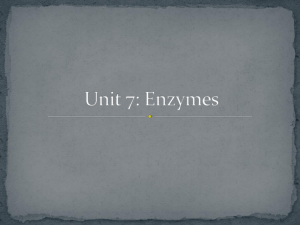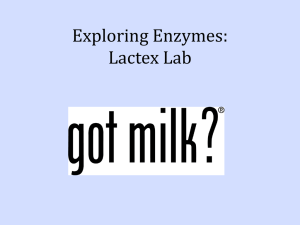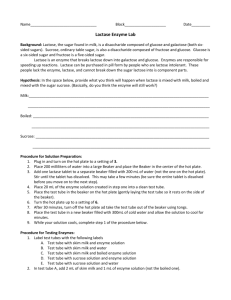Lactase Enzyme Lab: Specificity & Denaturation
advertisement
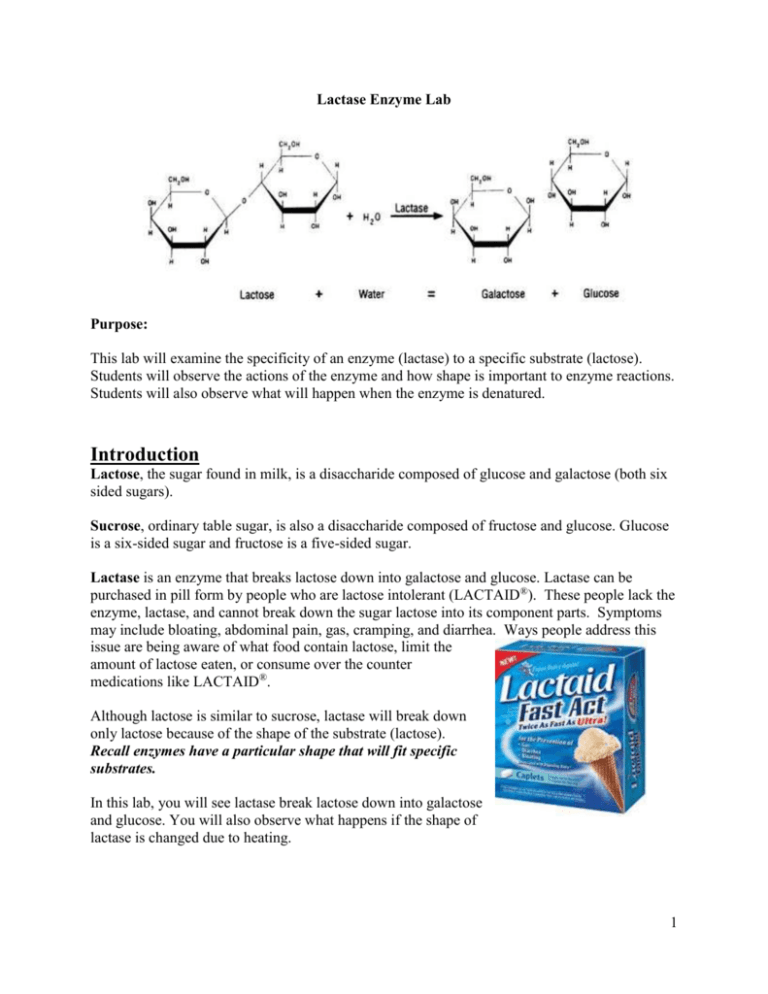
Lactase Enzyme Lab Purpose: This lab will examine the specificity of an enzyme (lactase) to a specific substrate (lactose). Students will observe the actions of the enzyme and how shape is important to enzyme reactions. Students will also observe what will happen when the enzyme is denatured. Introduction Lactose, the sugar found in milk, is a disaccharide composed of glucose and galactose (both six sided sugars). Sucrose, ordinary table sugar, is also a disaccharide composed of fructose and glucose. Glucose is a six-sided sugar and fructose is a five-sided sugar. Lactase is an enzyme that breaks lactose down into galactose and glucose. Lactase can be purchased in pill form by people who are lactose intolerant (LACTAID®). These people lack the enzyme, lactase, and cannot break down the sugar lactose into its component parts. Symptoms may include bloating, abdominal pain, gas, cramping, and diarrhea. Ways people address this issue are being aware of what food contain lactose, limit the amount of lactose eaten, or consume over the counter medications like LACTAID®. Although lactose is similar to sucrose, lactase will break down only lactose because of the shape of the substrate (lactose). Recall enzymes have a particular shape that will fit specific substrates. In this lab, you will see lactase break lactose down into galactose and glucose. You will also observe what happens if the shape of lactase is changed due to heating. 1 Hypothesis: If I add lactase to the milk solution, then I can expect ______________________________________________________ ______________________________________________________ If I were to boil the lactase and add it to the milk solution then… ______________________________________________________ ______________________________________________________ If I were to expose the lactase to sucrose, then I would expect ______________________________________________________ Variables: Controlled variables: milk, lactase Responding variable: presence or absence of glucose Manipulated variables and experimental test (boiled lactase)_____________________________________ (sucrose) __________________________________________ Materials 2 Lactase solution-dissolve 1 tablet in approx. 200 ml of water 50 ml milk- any milk will do Water-used for dissolving the lactase tablet, dissolving the sucrose and boiling the lactase Sucrose-saturated solution, 100ml will be plenty for each class Spot plate Disposable plastic pipettes to be used as droppers for the different solutions 1 spot plate- these hold the different solution mixtures glucose test strips- these can be found in drugstores or purchased online boiled lactase solution - dissolve 1 tablet in approx. 500ml of water and boil for several minutes (Teacher does this prior to lab) Lab Procedures: 1. Each group needs a spot plate and 5 glucose test strips. Set your spot plate on a blank sheet of paper and label spots A, B, C, D, E (see above). 2. Label the sheet to keep track of what solution will go in which spot a. b. c. d. e. milk and enzyme solution milk and water milk and denatured enzyme solution sucrose solution and enzyme solution sucrose solution and water 3. In spot A add 10 drops of milk and 10 drops of enzyme solution 4. Time for 2 minutes and test for glucose with the glucose test tape. Record this data in table 1. If there was glucose present mark a “+” in the table. If glucose was absent, mark a “-“ in the table (positive and negative signs). 5. In spot B add 10 drops of milk and 10 drops of water. 6. repeat step 4 7. In spot C add 10 drops of milk and 10 drops of denatured enzyme solution 8. repeat step 4 9. In spot D add 10 drops of the sucrose solution and 10 drops of enzyme solution 10. repeat step 4 11. In spot E add 10 drops of the sucrose solution and 10 drops of water 12. repeat step 4 3 Lactase Enzyme Lab Data Sheet Glucose Test Results Type of Solution Test A: milk and enzyme solution Glucose Test (+ or -) Test B: milk and water Test C: milk and denatured enzyme solution Test D: sucrose solution and enzyme solution Test E: Sucrose solution and water Discuss the above results in your group. Write a few sentences here, explaining these results. Analysis and Conclusion. 1. Diagram and describe the lactose and lactase reaction. In your description try to use several or all of these terms: active site binding breaking catalyzing covalent bonds denatured enzyme products specific substrate 4 2. Why did the enzyme react to lactose but not to sucrose? 3. What happened when the enzyme was boiled, specifically, what did the heat alter? 4. Another way to affect the enzyme is by lowering the pH of the solution. However, lactase is supposed to be able to work in the stomach. Would lowering the pH of the enzyme solution affect the enzyme? Why or why not? 5. State a new question or hypothesis that could be tested with this enzyme and substrate. 5 Lactase Enzyme Lab Teachers Answer Sheet Teachers will be able to assess the results table (the only positive reaction should be test tube A) and the teacher will be able to correct the conclusion questions. Answer Key 1. the students should draw a hydrolysis-induced fit model 2. The shape of sucrose (glucose and fructose) is different from lactose (glucose and galactose). The sucrose will not fit into the active site of lactose. 3. The enzyme denatured. The hydrogen atoms vibrated so much due to the energy added to quaternary structure of the enzyme. Note: as long as the students understand that the bonds broke changing the enzyme shape, they are ok. 4. The enzyme will denature (eventually). The H+ will interfere with the hydrogen bonds, and denature the enzyme. 5. The reaction is a hydrolysis reaction. Supplemental Information Denaturing the enzyme was very difficult. We had to boil the enzyme (placing a test tube with the enzyme in a beaker of boiling water) for 30 minutes. We thought about lowering the pH of the enzyme solution, but commercial lactase is swallowed and works in the stomach, so lowering the pH was not really an option for us. We experimented by boiling the lactase for five, ten and fifteen minutes. Thirty minutes worked for us. We suggest that you try boiling the enzyme before the lab, adding some milk (source of lactose) and test for glucose. If glucose is present, boil the lactase for a longer period of time. You can approach the enzyme specificity in two different ways: 1. Why didn’t the sucrose break down in the presence of lactase? 2. Why didn’t the lactose break own in the presence of boiled lactose? This lab is an uncomplicated introduction to enzyme reactions. Comments This lab is a relatively simple lab which shows the specificity of enzymes based on shape. You will need to purchase lactaid and glucose test strips. I suggest the glucose test strips from Science Kits and Boreal Labs, which are easy to use. You might want to set up the solutions before the lab (if you are pressed for time). This will simplify the lab for the students. www.lrsd2.org/files/edservices/10sLactaseEnzymeLab.doc 6
